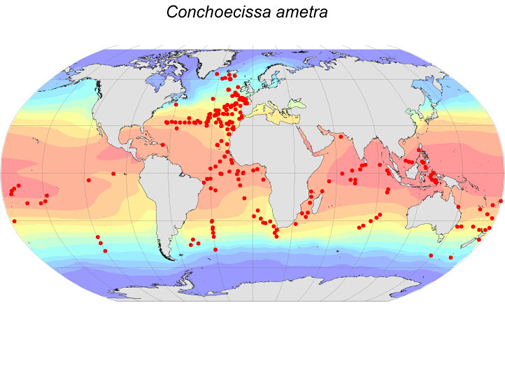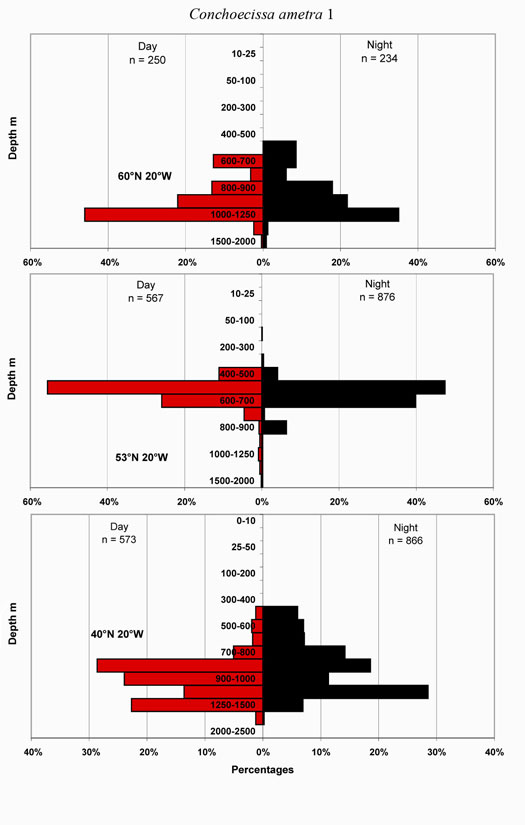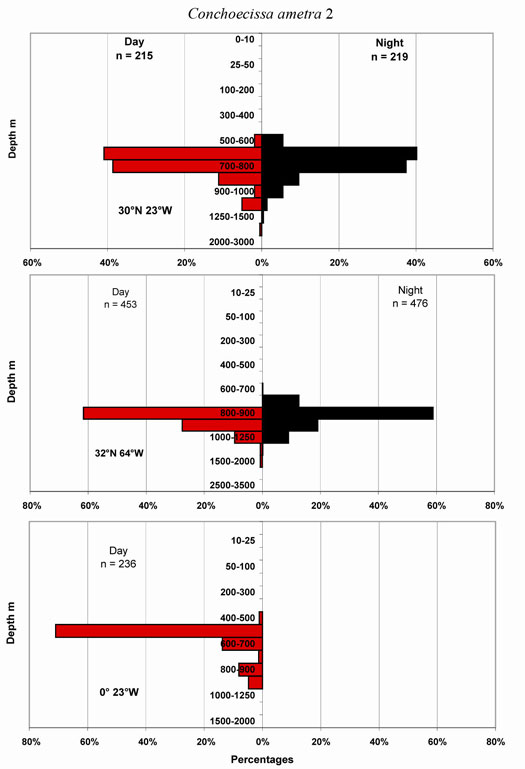Notes
480 records
This is a large, highly
ornamented bathypelagic species that has been reported from all oceans,
except the North Pacific. Müller (1906) placed it with three or four,
other species in his “
imbricata group”, which also
included the only then known species of Claus’s genus
Conchoecissa.
Skogsberg (1920) was in general agreement with Müller’s
groupings but excluded the species that is now known as
Platyconchoecia
prosadene. Poulsen (1973) resurrected Claus’s genus including in
it all the species of the “
imbricata group”, but
pointed out (p.181) that
C. squamosa is “set a little apart
from the other four”.
C. ametra predominantly occurs at
latitudes <40° except in the North Atlantic where it is abundant at
latitudes of over 60°N possible as a result of the North Atlantic
Drift. Its range does not extend into the Southern Ocean, where it is
replaced by
symmetrica. It is often subdominant in the ostracod
populations at depths of around 1000m, if not numerically, then certainly
in terms of biomass. The bathymetric profiles show that it is a deep
mesopelagic to bathypelagic species. The rostra are asymmetrically developed.
The right asymmetrical gland opens on a tubercle at the posterior ventral
corner, and there is a corresponding tubercle on the left carapace valve.
Bioluminescence is produced and retained within glands situated within the
posterior ventral tubercles, the tips of the rostra and the tips of the
short spines at the posterior dorsal corner, possibly as a device to deter
visually feeding predators by appearing to be as large as possible. Living
specimens are coloured bright scarlet; probably coloured by the same
carotenoids that occur in the decapod crustaceans at deep mesopelagic
depths. Note, not only is this coloration functionally black, because
there is no red light at such depths, but also the pigment is
non-reflective to the light of blue-green wave-lengths emitted by most
bioluminescent organisms.
| Bermuda
|
n
|
Mean mm
|
s.d.
|
Range mm
|
|---|
| Female
|
48
|
4.01
|
0.288
|
3.48-4.40
|
|---|
| Male
|
49
|
3.63
|
0.216
|
3.17-4.17
|
|---|
| A-1
|
207
|
2.83
|
0.142
|
2.40-3.20
|
|---|
| A-2
|
191
|
1.86
|
0.095
|
1.60-2.12
|
|---|
| A-3
| 216
|
1.25
|
0.052
|
1.08-1.44
|
|---|
| A-4
|
104
|
0.83
|
0.029
|
0.74-0.90
|
|---|
| A-5
|
1
|
0.60
|
|
|
|---|
| Equador
|
n
|
Mean mm
|
s.d.
|
Range mm
|
|---|
| Female
|
34
|
4.30
|
0.100
|
4.08-4.44
|
|---|
| Male
|
|
|
|
|
|---|
| A-1
|
54
|
2.85
|
0.122
|
2.25-3.08
|
|---|
| A-2
|
58
|
1.85
|
0.070
|
1.70-1.96
|
|---|
| A-3
|
20
|
1.20
|
0.044
|
1.12-1.28
|
|---|
| A-4
|
1
|
0.72
|
|
|
|---|
| A-5
|
34
|
4.30
|
0.100
|
4.08-4.44
|
|---|
| 44°N
|
n
|
Mean mm
|
s.d.
|
Range mm
|
|---|
| Female
|
23
|
3.95
|
0.139
|
3.68-4.12
|
|---|
| Male
|
|
|
|
|
|---|
| A-1
|
79
|
2.66
|
0.108
|
2.36-2.88
|
|---|
| A-2
|
94
|
1.75
|
0.073
|
1.58-1.94
|
|---|
| A-3
| 53
|
1.14
|
0.049
|
1.00-1.24
|
|---|
| A-4
|
2
|
0.84
|
|
0.82-0.86
|
|---|
| A-5
|
23
|
3.95
|
0.139
|
3.68-4.12
|
|---|
| Azores Front
|
n
|
Mean mm
|
s.d.
|
Range mm
|
|---|
| Female
|
14
|
4.04
|
0.211
|
|
|---|
| Male
|
13
|
3.55
|
0.067
|
|
|---|
| A-1
|
8
|
2.89
|
0.091
|
|
|---|
| A-2
|
6
|
1.81
|
0.064
|
|
|---|
| A-3
|
5
|
1.24
|
0.034
|
|
|---|
| A-4
|
1
|
0.74
|
|
|
|---|
| A-5
|
|
|
|
|
|---|






